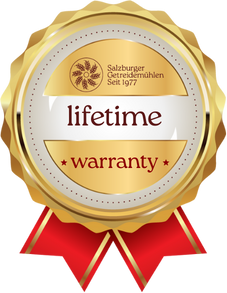The use of a
hand mill
is definitely necessary and correct in areas without an electrical supply.
Our hand grain mills with granite millstones have been doing good, reliable work for decades on mountain pastures, on yachts, etc., but also in some developing countries around the world or in areas without an electricity supply.
Many of our customers purchase a hand grinder in times of crisis so that they can provide for themselves, family and friends without the need for electricity.
But even raw foodists do not shy away from manual labor in order to process the grain as naturally as possible.
Of course, grinding by hand is the gentlest way of grinding and we are sometimes told that this flour tastes “even better”.
But we can also tell you that this manual work is quite strenuous and time-consuming. The purchase of a hand grinder for daily use is therefore really worth considering.
The MH 4 hand mill is sufficient as a precaution for times of crisis. Without electricity, we certainly have enough time to turn the crank.
If you still want a hand grinder for everyday use, we recommend that you take a look at the MH 8 grinder.
This grinder grinds almost as quickly and efficiently as an electric grinder – but with effort!
As the name suggests, natural stone is formed over thousands of years in nature.
They do not need any human help to develop, they do not need any additives or binding agents, they are pure nature.
The granite stones we use are extracted from a European quarry and then processed by hand. Each pair of stones we install is unique.
We are not aware of any allergic reactions to the natural stone.
We are also not aware of natural stone breaking (due to impurities in the grain). We are therefore able to offer a 24-year guarantee on these stones (or even longer if desired). A good feeling for your teeth!
Granite stones are usuallyreground by us after 20 – 30 years (depending on which grain has been milled).
The corundum-ceramic grinding stones most commonly used today are manufactured synthetically. Contrary to popular belief, no naturally mined corundum can be used to produce artificial corundum ceramic grinding stones.
The abrasion of the stones during grinding is also known as stone grit (particularly common in older mills).
The number of revolutions depends on your personal commitment.
With the hand mill MH 4
you can produce approx. 40 – 45 grams of fine bread flour (at approx. 70 rpm). We therefore only recommend this mill for presentation purposes in schools and kindergartens, to take with you when traveling and for people who really only need very small amounts of flour or meal
With the hand mill MH 8
(approx. 90 rpm), you can grind almost as quickly as with an electric mill – up to 90 grams of fine bread flour per minute.
Raw foodists in particular attach great importance to heating the grain to no more than 40 degrees.
For them, the purchase of a hand mill is right because they do not bake bread and do not otherwise need large quantities of flour.
The only question is whether a hand mill or a flake crusher is the right choice.
If you only need flakes (e.g. for muesli or soups), then the
Salzburg Flake Master
or
gear flaker
is completely sufficient.
Of course, grinding by hand is the gentlest way of grinding and we are sometimes told that this flour tastes “even better”.
But we can also tell you that this manual work is quite strenuous and time-consuming. The purchase of a hand grinder for daily use is therefore really worth considering.
If you still want a hand grinder for everyday use, we recommend that you take a look at the MH 8 grinder.
This grinder grinds almost as quickly and efficiently as an electric grinder – and with little effort!
It is not easy to give the right answer here!
First and foremost, the grinding performance depends on you, it depends on how fast you turn the crank.
Grinding large, hard grains requires more power than grinding wheat or spelt.
The flour fineness setting must also be taken into account. The finer you grind, the longer you have to grind and the more strenuous it is.
For example, if you work with the hand mill MH 4 for example, with 40 revolutions per minute and produce between 40 and 50 grams per minute, you will need 15 minutes to produce half a kilo of fine bread flour
If you need the finest flour for cakes, you will need about 30 minutes.
Of course, grinding by hand is the gentlest way of grinding and we are sometimes told that this flour tastes “even better”.
But now you also know that this manual work is quite strenuous and time-consuming. The purchase of a hand grinder for daily use is therefore really worth considering.
If you still want a hand grinder for everyday use, we recommend that you take a look at the MH 8 grinder.
This grinder grinds almost as quickly and efficiently as an electric grinder.
You can grind approx. 90 grams of flour in one minute with little effort.
The difference to the MAX grain mill is the grinding of the millstones, which must meet particularly high standards.
The MAX SPEZIAL grinder also grinds large and hard grains such as:
Address:
Gasteigweg 25,
5400 Hallein
Austria
Opening hours:
Monday to Thursday: 09 – 16:00
Friday: 09 – 12:00
Contact:
Phone: +43 6245 83282
E-mail: [email protected]

Address:
Gasteigweg 25,
5400 Hallein
Austria
Opening hours:
Monday to Thursday: 09 – 16:00
Friday: 09 – 12:00
Contact:
Phone: +43 6245 83282
E-mail: [email protected]


